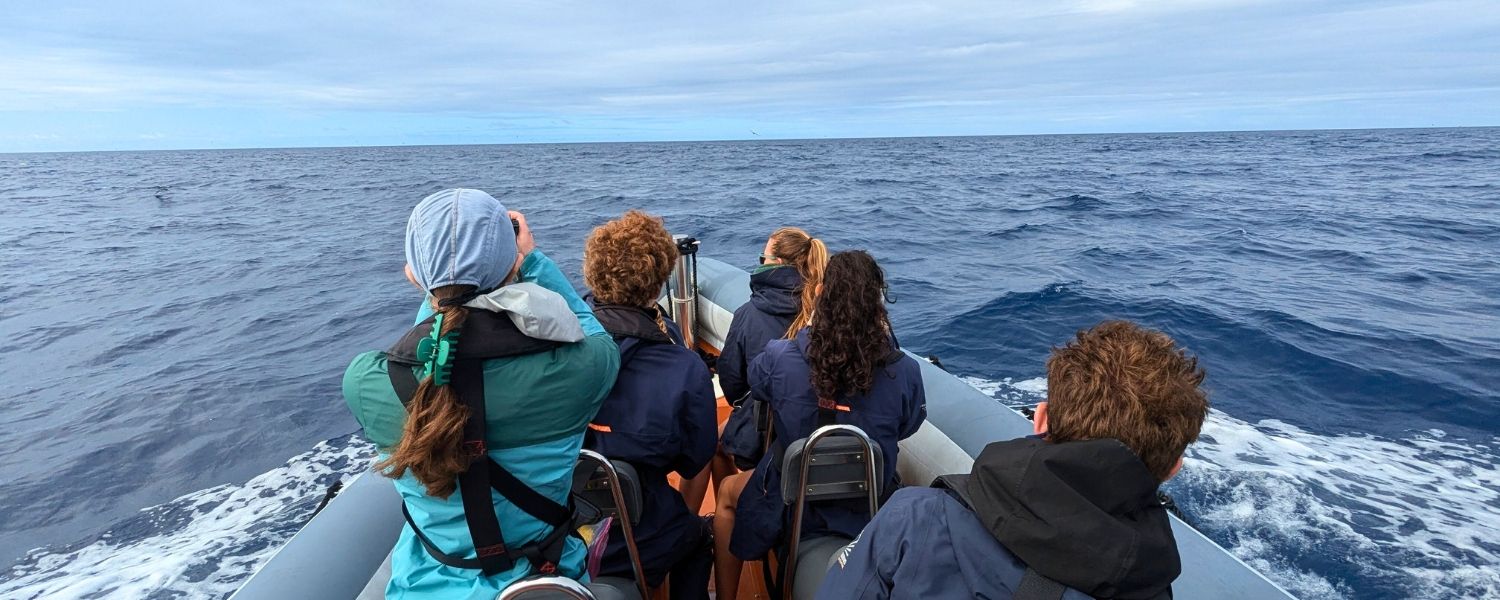
Whales and the Azores: A Journey from Whaling to Conservation
By: Chelsey Thwaites, Program Director February 14, 2025 High School Adventures, Marine Biology, Wildlife Conservation
The Azores, sometimes called the ‘Hawai’i of Europe’, is an archipelago of volcanic islands in the North Atlantic Ocean and is one of the best destinations in the world for whale watching. With its deep waters and nutrient-rich currents, the region is a vital habitat and migratory path for a diverse range of cetaceans. Today, the Azores are a beacon of marine conservation, but their relationship with whales has not always been one of admiration and protection.
What Whales Can You Observe in the Azores?
The Azores are home to more than 20 species of whales and dolphins, making them one of the world’s most diverse marine mammal hotspots. Unlike seeing animals at a zoo or aquarium, there are no guarantees when spotting whales in the wild. However, some of the species you’d be most likely to see in the Azores include:
- Sperm Whales (Physeter macrocephalus): The most iconic whale in the Azores, sperm whales can be seen year-round. The waters provide an ideal feeding ground for these deep-diving giants, which hunt squid in the ocean depths.
- Blue Whales (Balaenoptera musculus): The largest animal on Earth, blue whales migrate past the Azores in the spring, offering lucky visitors a chance to witness their immense presence.
- Fin Whales (Balaenoptera physalus): Frequently spotted during their migration, fin whales are the second-largest whale species. They are known for their sleek, fast-swimming nature.
- Humpback Whales (Megaptera novaeangliae): These acrobatic whales pass through the Azores on their migratory routes, thrilling watchers with their breaches and tail slaps.
- Pilot Whales (Globicephala spp.): These social, medium-sized whales travel in pods and are often seen resting near the surface in the Azorean waters.
The Whaling History of the Azores
For over a century, whaling was a primary industry in the Azores. Beginning in the early 19th century, Azorean whalers primarily hunted sperm whales. Sperm whales were prized for their oil, used for lamps and lubricants, and later in industrial applications. The whaling industry provided employment and economic stability to many islanders, and traditional techniques—such as hand-thrown harpoons launched from small boats—defined the Azorean approach to whaling.
The industry peaked in the mid-20th century but began to decline as global awareness of whale populations grew and alternative resources were developed. In 1984, Portugal officially banned whaling, and the whaling stations that once dotted the islands fell silent.
The Importance of Whales in the Ecosystem
Whales play a crucial role in maintaining the health of marine ecosystems. Whales consume vast amounts of krill and other tiny organisms, helping to control populations of their choice prey. They also play a crucial role in cycling nutrients throughout the ocean. As they dive and surface, they help mix ocean layers, redistributing nutrients that support plankton growth—the foundation of the aquatic food web. When they migrate, their migration routes help transport nutrients across long distances across the ocean. Their fecal matter acts as a natural fertilizer, promoting the growth of phytoplankton, which in turn absorbs carbon dioxide from the atmosphere and produces oxygen. Additionally, when whales die, their bodies sink to the ocean floor, providing a significant source of nutrients for deep-sea organisms. Many whale species, such as blue whales, are endangered or critically endangered today.
The Transition to Whale Conservation
With the end of whaling, the Azores embarked on a new era—one focused on whale conservation and ecotourism. Many former whalers found a new livelihood as whale-watching guides, using their intimate knowledge of whale behavior to help visitors spot these majestic creatures in the wild.
Today, the Azores are a leader in marine conservation, with strict regulations to ensure responsible whale-watching practices. The region boasts several marine protected areas, research initiatives, and educational programs aimed at preserving the rich biodiversity of its waters. Local organizations and scientists study whale populations, migration patterns, and the impact of climate change on marine life.
Whale Watching in the Azores
Whale-watching tours are an important attraction in the Azores, offering visitors a chance to see these incredible animals in their natural habitat. Tours operate under guidelines designed to minimize stress on the animals. For example, they take precautions like keeping a respectful distance, limiting boat traffic, and ensuring that interactions remain as natural as possible.
The transformation of the Azores from a whaling hub to a sanctuary for whales is a remarkable story of resilience and change. Today, the islands stand as a testament to the power of conservation, proving that economic and environmental interests can coexist in harmony.
Our Azores Whale and Dolphin Experience
Are you interested in conservation and marine biology, particularly marine mammals? Our Azores Whale + Dolphin Experience offers high school students the unique opportunity to see various species of dolphins and whales in their natural habitat while also observing and contributing to research and local conservation efforts. Led by experienced marine biologists and local guides, you’ll learn about whale behavior and the diverse species found in these waters. Whether you’re lucky enough to witness the rare sight of a humpback whale breaching or the playful antics of dolphins, this experience is a must for any future marine biologist.
